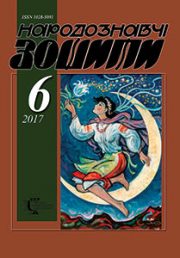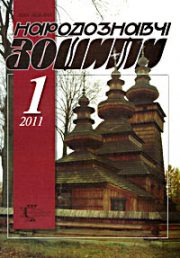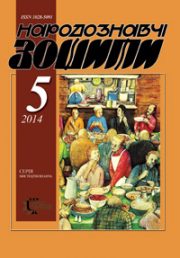The Ethnology Notebooks. 2018, 2 (140), 478—482.
UDK 78.087.5
DOI https://doi.org/10.15407/nz2018.02.478
Received 25.01.2018
ORGANIZATION OF EDUCATIONAL PRACTICE IN THE DNIPROPETROVSK ACADEMY OF MUSIC NAMED AFTER. M. GLINKA
Klymchyk Iryna, Head of Education Practice,
Dnipropetrovsk Music Academy named after M. Glinka .
10 Lyvarna str., Dnipro, 49044, Ukraine
Abstrakt. The influence of educational practice on improving the professional training of graduates of the Dnipropetrovsk Academy of Music named after. M. Glinka is under investigation. The value of folklore’s component is traced. The problem of popularization of intangible musical heritage of Dnipropetrovsk region as an important component of the future professional activity of graduates of higher educational institutions is raised.
Keywords: educational practice, concert-executive practice, pedagogical practice, practice with chorus (ensemble, orchestra, chapel), archival-bibliographic practice, musical folklore.
REFERENCES
Dec, N.I. & Maslova R.R. (2009). Pedagogicheskaja praktika u studentov ispolnitel’skih special’nostej vuzov iskusstv (uchebno-metodicheskoe posobie). Volgograd [in Russian].
Kozats’ki pisni Dnipropetrovschyny. (2015). In Udoda Ye.H. (perednie slovo); Dnipropetrovs’ka konservatoriia im. M. Hlinky (uporiad.). Dnipropetrovs’k: LizunovPres [in Ukrainian].
Martyniuk, V.M., Ovcharova S.V. & Schitova S.A. (2017). Ukrains’ka pisnia u polifonichnykh tvo¬rakh dlia bandury: navchal’nyj posibnyk. Dnipro: LIRA [in Ukrainian].
Halyna Pshenichkina & Anastasiia Liubymova (uporiadnyky). (2016). Narodni pisni suchasnoi Dniprolpetrovschyny. (Vypusk 1. Tomakivs’kyj rajon). Dnipro: LIRA [in Ukrainian].
Ovcharova, S.V. & Ovcharov, V.S. (2017). Instrumentavannia tvoriv dlia kapely bandurystiv ta strunnoho orkestru: navch.-metod. posib. Dnipro: LIRA [in Ukrainian].
Ovcharova, S.V. & Ovcharov, V.S. (2017). Instrumentuvannia dlia kapely bandurystiv z orkestrovoiu hrupoiu: navch.-metod. posib. Dnipro: LIRA [in Ukrainian].
Ovcharova, S.V. & Ovcharov, V.S. (2017). Pedahohichnyj repertuar dlia kapely bandurystiv z orkestrovoiu hrupoiu: navchal’no-metodychnyj posibnyk. Dnipro: LIRA [in Ukrainian].
Rostovs’kyj, O.Ya. (1997). Pedahohika muzychnoho spryjmannia: Navch.-metod. Posibnyk. Kyiv: IZMN [in Ukrainian].
Fejgin, M.Je. (1973). Vospitanie i sovershenstvovanie muzykanta-pedagoga. Moskva: Sovetskij kompozitor [in Russian].
Furduj, Yu.V. (2017). Muzychni propysy: dlia ditej vid 4 rokiv. Dnipro: LIRA [in Ukrainian].
Hananaeva, V.E. (1985). Formirovanie professional’no-pedagogicheskoj napravlennosti ispolnitelja v muzykal’nom vuze: avtoref. disser. kand. iskusstvov. Leningrad [in Russian].
Hananaeva, V.E. (1984). Razvitie pedagogicheskogo myshlenija u studentov muzykal’nyh vuzov. In Problemy kompleksnogo tvorcheskogo vospitanija muzykanta-ispolnitelja. Novosibirsk [in Russian].
Khananaiev, S.V. (2016). Do pytannia vzaiemodii tvorchykh praktyk. Zb. nauk. statej. Muzykoznavcha dumka Dnipropetrovschyny. (Vyp. 11) Dnipro: LIRA [in Ukrainian].
Khananaiev, S.V. (2010). Chynnyky formuvannia pedahohichnoho dosvidu. Praktychni rekomendatsii. Zb. nauk. statej. Muzykoznavcha dumka Dnipropetrovschyny. (Vyp. 5). Dnipropetrovs’k: Yurij Serdiuk [in Ukrainian].
Pshenichkina, H. & Liubymova, A. Krynychans’kyj rajon. Retrieved from: http://www.krinich-rn.dp.gov.ua/OBLADM/krinch_rda.nsf/docs/0268F2BD88DACFF2C2257F690059E468?opendocument&PrintForm







